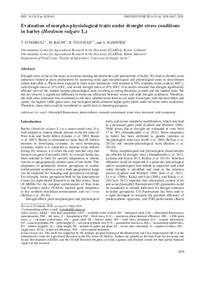Evaluation of morpho-physiological traits under drought stress conditions in barley (Hordeum vulgare L.)

Authors:
Drought stress is one of the major constraints limiting the production and productivity of barley. We tried to identify some indicators related to plant productivity by analyzing some agro-morphological and physiological traits in recombinant inbred lines (RILs). Plants were exposed to three water treatments: well-watered at 70% available water content (AWC), mild drought stress at 35% AWC, and severe drought stress at 10% AWC. Our results revealed that drought significantly affected most of the studied morpho-physiological traits resulting in strong decreases in yield and the studied traits. We did not observe a significant difference in water-use efficiency between severe and mild drought conditions. Therefore, the mild stress treatment was considered as the most suitable water level in our study. Genotypes with the most tillers and spikes, the highest 1,000-grain mass, and biological yields achieved higher grain yields under all water stress conditions. Therefore, these traits could be considered as useful tools in breeding programs.
